Ufa, Ufa, Russian Federation
Abstract. The purpose is to study the features of biology (the onset of the main phenological phases of seasonal growth and development, the morphology of the vegetative and generative spheres, laboratory germination of seeds, vegetative reproduction) and the chemical composition (above-ground part in various phases of vegetation) of Chrysanthemum zawadskii under the conditions of the South Ural Botanical Garden Institute of UFRC RAS. Methods. Introduction tests (study of phenology, morphometry, etc.) were carried out according to standard methods. Germination of own reproduction seeds is carried out in accordance with the procedure in laboratory conditions in petri dishes in two versions: without stratification and with preliminary stratification. Qualitative and quantitative determination of ash, macro- and trace elements, and some biologically active substances contained in the aboveground part of Ch. zawadskii was carried out using known and modified techniques. Results. Ch. zawadskii is characterized by the complete life cycle of development, a long-growing plant (155 days), with late-spring growth of shoots, from the group of long-flowering plants (more than 20 days). Seeds ripen massively in mid-September. The studied rare species has medicinal properties due to the content of certain groups of biologically active substances in the above-ground part of plants. A study of the chemical composition in various developmental phenophases showed that the highest content of ascorbic acid and flavonoids is observed in grass collected in the flowering phase, tannins in a larger amount accumulate in leaves collected in the fruiting phase, and in a smaller amount in flowers collected in the flowering phase. The greatest accumulation of organic acids and extractive substances is observed in plant flowers collected in the flowering phase. More macro- and trace elements in Ch. zawadskii accumulates in grass and leaves, regardless of the phenological phase of development. The presence of eight essential and six replaceable amino acids has been established. Scientific novelty. For the first time in the Republic of Bashkortostan, the chemical composition of the Ch. zawadskii, a rare resource medicinal plant, was studied.
Chrysanthemum zawadskii, phenology, raw materials, chemical composition, flavonoids, tannins, amino acids
1. Mironova L. N., Reut A. A. Kratkie itogi introdukcii dekorativnyh mnogoletnikov v Bashkortostane // Subtropicheskoe i dekorativnoe sadovodstvo. 2016. № 56. S. 64-69. EDN: https://elibrary.ru/TPNHSA
2. Teteryuk L. V., Kanev V. A., Valuyskih O. E., Teteryuk B. Yu. Redkie i ohranyaemye rasteniya vo flore yuzhnoy chasti nacional'nogo parka «Yugyd Va» (Respubliki Komi) // Botanicheskiy zhurnal. 2019. T. 104. № 8. S. 1283-1298. DOI:https://doi.org/10.1134/S0006813619080118. EDN: https://elibrary.ru/HYKMUL
3. Teteryuk L. V., Degteva S. V., Kanev V. A., Valuyskih O. E., Teteryuk B. Yu., Kulyugina E. E. Redkie i ohranyaemye rasteniya nacional'nogo parka «Yugyd Va» (Rossiya) // Nature Conservation Research. Zapovednaya nauka. 2020. T. 5. № 4. S. 16-29. DOI:https://doi.org/10.24189/ncr.2020.051. EDN: https://elibrary.ru/TCUGPA
4. Bobrov Yu. A., Chudinova I. A., Bulysheva V. V., Pozdeeva L. M. Biomorfy ohranyaemyh rasteniy Respubliki Komi // Biologicheskiy zhurnal. 2019. № 1 (1). S. 4-8. DOI:https://doi.org/10.32743/2658-6460.2019.1.1.37. EDN: https://elibrary.ru/NJJSJD
5. Krasnaya kniga Respubliki Bashkortostan: v 2 t. T. 1: Rasteniya i griby / Pod red. d-ra biol. nauk V. B. Martynenko. 3-e izd., dop. i pererabot. Moskva: Studiya onlayn, 2021. 392 s.
6. Mullagulov R. Yu., Mullagulova E. R. Chrysanthemum zawadskii Herbich na territorii nacional'nogo parka «Bashkiriya»: sostoyanie cenopopulyaciy, voprosy ohrany // Voprosy stepevedeniya. 2019. № HV. S. 221-224. DOI:https://doi.org/10.24411/9999-006A-2019-11532. EDN: https://elibrary.ru/SHMRDI
7. Rasteniya Yuzhno-Ural'skogo botanicheskogo sada-instituta UFIC RAN. Ufa: Mir pechati, 2019. 304 s.
8. Abramova L. M., Karimova O. A, Vafin R. V., Mironova L. N. Redkie vidy Urala i Povolzh'ya v kollekciyah Botanicheskogo sada g. Ufy // Fitoraznoobrazie Vostochnoy Evropy. 2016. T. 10. № 3. S. 97-127. EDN: https://elibrary.ru/WNGPRV
9. Vronskaya O. O., Rodnova T. V. Introdukciya redkih i ischezayuschih vidov v Kuzbasskom botanicheskom sadu // Problemy botaniki Yuzhnoy Sibiri i Mongolii. 2019. № 18. S. 566-569. DOI:https://doi.org/10.14258/pbssm.2019119. EDN: https://elibrary.ru/SMQETZ
10. Minin A. A., Ananin A. A., Buyvolov Yu. A., Larin E. G., Lebedev P. A., Polikarpova N. V., Prokosheva I. V., Rudenko M. I., Sapel'nikova I. I., Fedotova V. G., Shuyskaya E. A., Yakovleva M. V., Yancer O. V. Rekomendacii po unifikacii fenologicheskih nablyudeniy v Rossii // Nature Conservation Research. Zapovednaya nauka. 2020. T. 5. № 4. S. 89-110. DOI:https://doi.org/10.24189/ncr.2020.060. EDN: https://elibrary.ru/WLAFWF
11. Soldatov S. A., Karpova G. A. Sposoby preodoleniya pokoya semyan i osobennosti kul'tivirovaniya rasteniy roda Iris v usloviyah in vitro // Izvestiya Vysshih uchebnyh zavedeniy. Povolzhskiy region. Estestvennye nauki. 2020. № 4 (32). S. 24-31. DOI:https://doi.org/10.21685/2307-9150-2020-4-3. EDN: https://elibrary.ru/FGMKVE
12. Brykalov A. V., Yakuba Yu. F., Pilipenko N. Yu., Belik E. V., Rishome P., Simone F., Gryadskih D. A. Sovremennye metody vydeleniya i issledovaniya biologicheski-aktivnyh veschestv i mikroorganizmov. Krasnodar: KubGAU, 2016. S. 37-46.
13. Gryadskih D. A., Brykalov A. V., Belik E. V. Izuchenie himicheskogo sostava lekarstvennyh rasteniy // Materialy i metody innovacionnyh issledovaniy i razrabotok: sbornik statey Mezhdunarodnoy nauchno-prakticheskoy konferencii. Samara, 2018. S. 22-28. EDN: https://elibrary.ru/YRIWBC
14. Makarova M. P., Syroeshkin A. V., Maksimova T. V., Matveeva I. S., Pleteneva T. V. Osobennosti ekspress-opredeleniya mikroelementov v lekarstvennyh i neoficinal'nyh rasteniyah // Razrabotka i registraciya lekarstvennyh sredstv. 2019. T. 8. № 2. S. 93-97. DOI:https://doi.org/10.33380/2305-2066-2019-8-2-93-97. EDN: https://elibrary.ru/FIDRNG
15. Goncharuk V. V., Syroeshkin A. V., Zlatskiy I. A., Uspenskaya E. V., Orekhova A. V., Levitskaya O. V., Dobrovolskiy V. I., Pleteneva T. V. Quasichemical description of the cell death kinetics of cellular biosensor Spirostomum Ambigua for testing the biological activity of aqueous solutions // Journal of Water Chemistry and Technology. 2017. No. 39 (2). Pp. 97-102. DOI:https://doi.org/10.3103/S1063455X17020072. EDN: https://elibrary.ru/ZXCVOT









